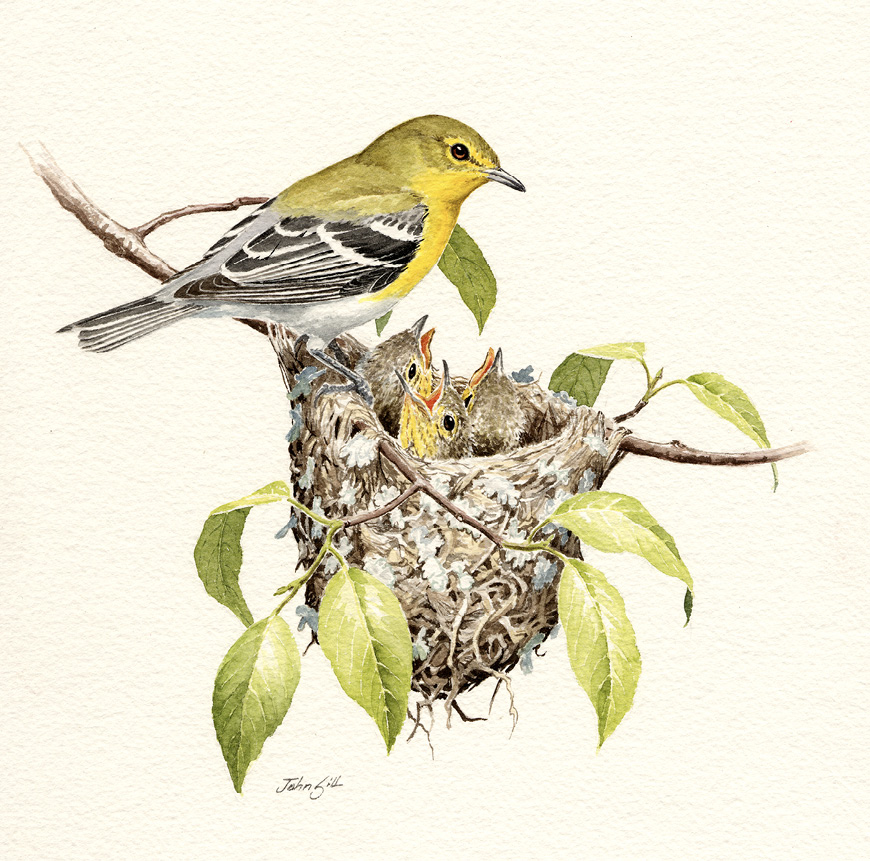Yellow-throated Vireo by John Sill

Yellow-throated Vireo by John Sill © Massachusetts Audubon Society. Courtesy of the Museum of American Bird Art.
John Sill is a freelance wildlife artist living in the mountains of North Carolina. He was the illustrator for the Bird Identification Calendar for Mass Audubon for many years. His work has appeared in Birds In Art at the Leigh-Yawkey Woodson Art Museum, Wausau, Wisconsin, and in Art of the Animal Kingdom at the Bennington Center for the Arts in Vermont. He continues to illustrate the "About" and "About Habitats" series of natural history books for children written by his wife Cathryn.
Yellow-throated Vireo
The Yellow-throated Vireo (Vireo flavifrons) is a beautiful bird but its biology is not well known, probably because it is uncommon through much of its breeding and wintering range. It is easily separated from other vireos by its yellow eye ring, throat, and breast and its white underparts and wing bars. The sexes are similar in plumage. Its large, stocky head and bill and short tail separate it from warbler species including the Pine Warbler, which it most closely resembles. The Yellow-throated Vireo is monotypic—having no subspecies—and appears to be closely related to the Blue-headed Vireo, which has similar breeding behavior and with which it occasionally hybridizes.
Yellow-throated Vireos are widely distributed throughout much of the eastern half of the United States, extending south to central Texas and northern Florida and Alabama along the Gulf Coast. Their breeding range also extends north into several places in southeastern Canada. They winter mainly in southern Mexico through Central America and south to Colombia and Venezuela, where they often forage in mixed-species flocks. Rarely, they winter in the Bahamas and other Caribbean islands. In Massachusetts, the Yellow-throated Vireo is considered an uncommon and local breeder, primarily in central and western Massachusetts, and is an uncommon to rare migrant in mid to late May and late August and September. They are typically solitary during migration.
Yellow-throated Vireos are thought to be monogamous, producing a single brood per season. Only the males sing a variable series of short buzzy phrases, which are usually separated by a second or more. Like other vireos, the song is probably learned. They also produce a variety of contact, scolding, and alarm calls. Males are territorial and may sing for most of the day until they secure a mate, after which singing is significantly reduced. Males will chase other males intruding into their territory and in aggressive situations will ruffle their head and body feathers and give scolding calls. The male selects the territory and may begin building a nest and use that site for its singing and displays involving feather fluffing. After pairing, the male mate-guards, following the female closely while she finishes building the nest.
Yellow-throated Vireos nest primarily in edge habitat in deciduous or deciduous/coniferous forests in mostly rural areas. The nest is usually in the crown of a deciduous tree. Initially, the male does most of the nest construction but the female progressively takes over the building responsibilities. Like most other vireo species, the nest is a cup suspended from a forked branch and consists of bark strips, grass, pine needles, and roots held together with spider web. The nest is lined with fine grass and often decorated with lichens, birch bark or even paper. The female develops an incubation (brood) patch and the male a partial one, with the female incubating the clutch of four dark spotted creamy or pinkish eggs at night and sharing duties with the male during the day. The eggs hatch after about two weeks and the young birds are altricial—helpless—and with their eyes closed at hatching. Both parents feed the chicks for the two weeks until fledging. Then they divide the brood and continued to feed them for an additional two weeks or more.
Yellow-throated Vireos are mostly bark and foliage gleaners, but occasionally they may hawk flying insects or hover-glean foliage. After catching a large insect they beat it against a branch, sometimes holding it against a branch with a foot while they dismember it. Usually insectivorous, they may sometimes take fruit in fall and winter.
In the nineteenth century Yellow-throated Vireos were widespread and relatively common in Massachusetts. By the early twentieth century they had noticeably decreased, reaching their current status by mid-century. Spraying of pesticides for Dutch elm disease and gypsy moth caterpillars may have precipitated local declines. There are few data on predation, but owls, hawks, and jays have been recorded taking adults and nestlings. Yellow-throated Vireos suffer significant cowbird nest parasitism in some areas. A current concern about their population decline is the deforestation of their wintering grounds. However, Breeding Bird Census data indicate a population increase of about 1% per year from 1966–1994, despite local declines. We certainly hope that this beautiful vireo will be with us into the future.
William E. Davis